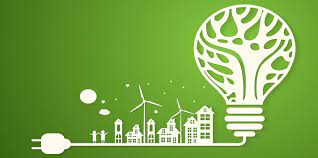Courtesy : en.wikipedia.org
Energy efficiency
Efficient energy use, sometimes simply called energy efficiency, is the process of reducing the amount of energy required to provide products and services. For example, insulating a building allows it to use less heating and cooling energy to achieve and maintain a thermal comfort. Installing light-emitting diode bulbs, fluorescent lighting, or natural skylight windows reduces the amount of energy required to attain the same level of illumination compared to using traditional incandescent light bulbs. Improvements in energy efficiency are generally achieved by adopting a more efficient technology or production processor by application of commonly accepted methods to reduce energy losses.
There are many motivations to improve energy efficiency. Decreasing energy use reduces energy costs and may result in a financial cost saving to consumers if the energy savings offset any additional costs of implementing an energy-efficient technology. Reducing energy use is also seen as a solution to the problem of minimizing greenhouse gas emissions. According to the International Energy Agency, improved energy efficiency in buildings, industrial processes and transportation could reduce the world’s energy needs in 2050 by one third, and help control global emissions of greenhouse gases.Another important solution is to remove government-led energy subsidies that promote high energy consumption and inefficient energy use in more than half of the countries in the world.
Energy efficiency and renewable energy are said to be the twin pillars of sustainable energy policy and are high priorities in the sustainable energy hierarchy. In many countries energy efficiency is also seen to have a national security benefit because it can be used to reduce the level of energy imports from foreign countries and may slow down the rate at which domestic energy resources are depleted.
Overview
Simplified electrical grid with energy storage
Further information: Domestic energy consumption
Energy efficiency has proved to be a cost-effective strategy for building economies without necessarily increasing energy consumption. For example, the state of California began implementing energy-efficiency measures in the mid-1970s, including building code and appliance standards with strict efficiency requirements. During the following years, California’s energy consumption has remained approximately flat on a per capita basis while national US consumption doubled.As part of its strategy, California implemented a “loading order” for new energy resources that puts energy efficiency first, renewable electricity supplies second, and new fossil-fired power plants last. States such as Connecticut and New York have created quasi-public Green Banks to help residential and commercial building-owners finance energy efficiency upgrades that reduce emissions and cut consumers’ energy costs.
Lovin’s Rocky Mountain Institute points out that in industrial settings, “there are abundant opportunities to save 70% to 90% of the energy and cost for lighting, fan, and pump systems; 50% for electric motors; and 60% in areas such as heating, cooling, office equipment, and appliances.” In general, up to 75% of the electricity used in the US today could be saved with efficiency measures that cost less than the electricity itself, the same holds true for home settings. The US Department of Energy has stated that there is potential for energy saving in the magnitude of 90 Billion kWh by increasing home energy efficiency.
Other studies have emphasized this. A report published in 2006 by the McKinsey Global Institute, asserted that “there are sufficient economically viable opportunities for energy-productivity improvements that could keep global energy-demand growth at less than 1 percent per annum”—less than half of the 2.2 percent average growth anticipated through 2020 in a business-as-usual scenario.Energy productivity, which measures the output and quality of goods and services per unit of energy input, can come from either reducing the amount of energy required to produce something, or from increasing the quantity or quality of goods and services from the same amount of energy.
The Vienna Climate Change Talks 2007 Report, under the auspices of the United Nations Framework Convention on Climate Change, clearly shows “that energy efficiency can achieve real emission reductions at low cost.”
International standards ISO 17743 and ISO 17742 provide a documented methodology for calculating and reporting on energy savings and energy efficiency for countries and cities.
The energy intensity of a country or region, the ratio of energy use to Gross Domestic Product or some other measure of economic output”, differs from its energy efficiency. Energy intensity is affected by climate, economic structure (e.g. services vs manufacturing), trade, as well as the energy efficiency of buildings, vehicles, and industry.

